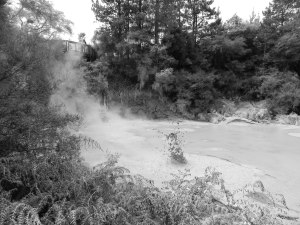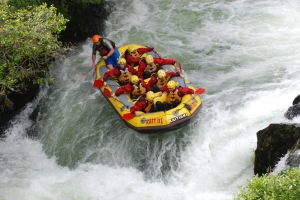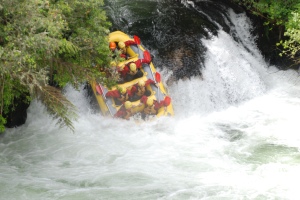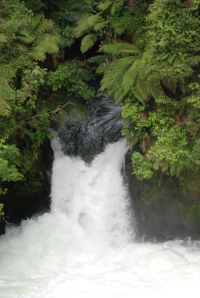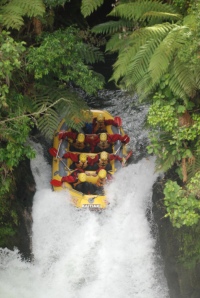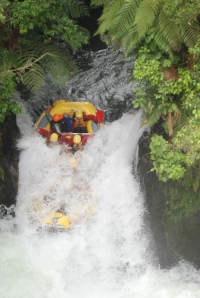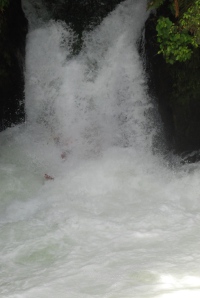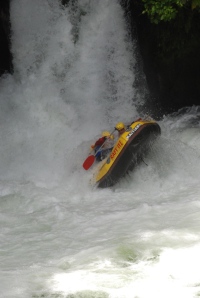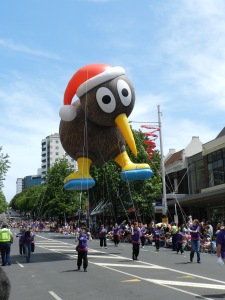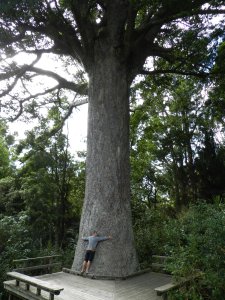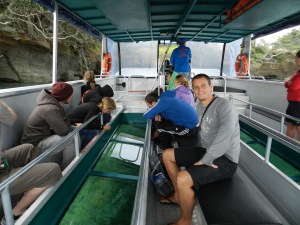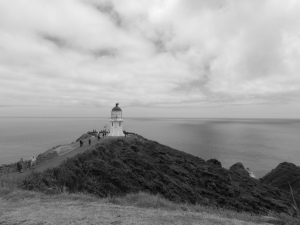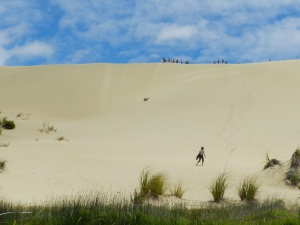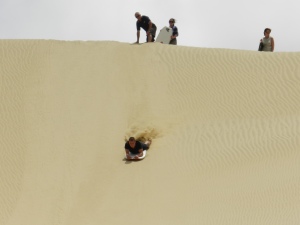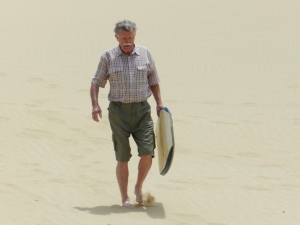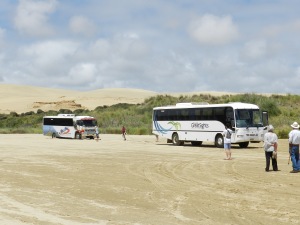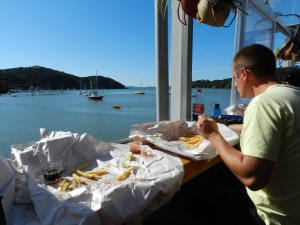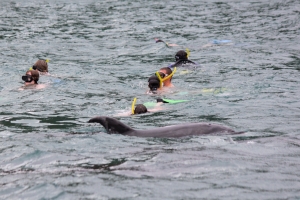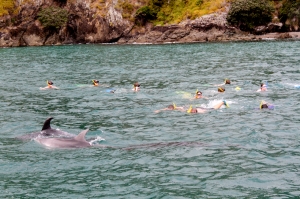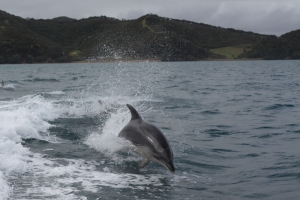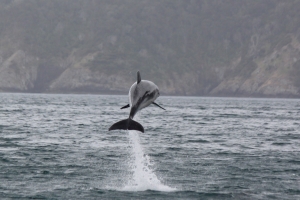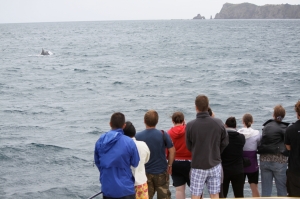Rotorua, Taupo, National Park, Auckland, Paihia, Auckland….
Rotorua is well known for its adventure sports and….smell of rotten eggs! The whole area is surrounded by geothermal activity and hot mud pools steam constantly throughout the parks and surrounding country giving off a sulphuric smell much like rotten eggs. The image below shows one such pool just outside Rotorua.
We mentioned in the last blog that we may take on the white water rafting in Rotorua. The bus journey south is designed to allow passengers to stop for the morning in Rotorua for white water rafting before continuing south towards the National Park.
The rafting in Rotorua is half the price of the south island and features the largest commercially rafted waterfall in the world – a 7 metre drop. This sealed the deal and was sure to provide some adrenalin.
Kaitiaki Rafting would be taking us down the river and with the translation from Maori meaning “Guardianship, Caretaker, Master” we were assured that we would be in safe hands. In order to preserve traditions and respect the Kaituna River, our guide started with a Maori prayer, always a reassuring start!
Following the rafting we purchased a picture disk so we can show you the stages of our river adventure.
The images below show the first and smaller three metre waterfall.
A little further down the river and we approached the seven metre waterfall. Our boat hung back and the other two boats went first meaning we had to ensure a longer wait watching to see how they survived the descent. Luckily we couldn’t see that people from both boats had fallen out.
One of the Irish guys we travelled with for some time had rafted the same river just a couple of weeks before. At the top of the big waterfall the boat went sideways and one girl actually fell out, evening up the boat for the others but meaning she took the full force of the water herself with the very real possibility of the boat landing on her!
The photos below show each stage of the descent and at one point we are totally submerged.
Can you see the relief on our faces?
With the rafting over and all of us surviving with no injuries we drove south toward Taupo, stopping briefly to admire the incredible amount of water flowing through the Huka Falls.
 We stopped before Taupo at a river which is warmed from geothermal water meeting the cold water of the river, creating a nice hot-tub temperature. The river was interesting until our guide told us that we could paddle and swim but not submerge our face as the river carried meningitis which could be contracted through the nasal system!
We stopped before Taupo at a river which is warmed from geothermal water meeting the cold water of the river, creating a nice hot-tub temperature. The river was interesting until our guide told us that we could paddle and swim but not submerge our face as the river carried meningitis which could be contracted through the nasal system!
Taupo is best know for its huge lake, the largest in New Zealand. If you look on a map of New Zealand you can quickly realise the scale. The lake actually isn’t as good as others in New Zealand for cruises and exploring, mostly due to its vast size. We would be breaking the journey in Taupo for one night before heading off early towards the National Park.
Two pieces of bad news awaited us in the morning. Our planned stop for the night at the highly recommended Blue Duck Lodge, set on a huge farming station near the National Park had been cancelled due to a previous large booking. We would therefore only be able to visit for the day. To add to this the weather wasn’t looking great so the Tongariro Alpine Crossing had been closed for the next two days, the main and only activity in the National Park.
Blue Duck Lodge made for a nice afternoon and most of the group spent it taking a walk into the depths of the vast farming station. Activities on offer here ranged from axe throwing and an eco off road tour to goat shooting. Emma spent much of the afternoon petting the two pet goats not keen on the shooting idea, even though goats in New Zealand are considered pests.
The cancellation at the Blue Duck Lodge meant that we would be spending three nights in the National Park. The accommodation here (very originally named “The Park”) was extremely nice and worked out well, with a three for two offer on accommodation. With two others from the group we secured a “loft room” with an en-suite, fridge and a mezzanine level for two of the beds. Coupled with the fantastic communal and bar areas, good internet and hot tubs it made for a relaxing three days. The alpine crossing unfortunately remained closed until the day we left. We had been really looking forward to making the 20km crossing, rated one of the best one day walks in the world.
We headed back the next day towards Auckland, spending a night in Rotorua in between. On this occasion we would have only one night in Auckland before our extra pass north to the Bay of Islands and Cape Reinga.
When the bus arrived in Auckland some of the roads were closed and we had to take a extended route to reach the hostel. Upon walking into the town centre the reason for the diversions became apparent. On a sunny, warm day with clear blue skies the city was holding its annual “Santa Parade” and carnival. Thousands of people lined the streets and around 150 floats came though making for some free afternoon entertainment.
Our base for the two nights north of Auckland was Paihia, the “gateway” to the Bay of Islands. En-route to Paihia we stopped to see an ancient Kauri tree.
The Kauri three is a huge tree with takes over a thousand years to mature. The timber from the tree is resistant to rot and therefore ideal for the manufacture of boats. Many years ago these trees provided big business for the loggers in New Zealand with the wood fetching a hefty price at the boat yards in Europe. The species is now few and far between and is in the (extremely lengthy) process of being re-planted. The trees are huge and this specimen was 16 metres in circumference.
The Stray pass included a glass-bottomed boat tour of a marine reserve. The first marine reserve in the world and therefore the longest protected area of sea in existence, it is now studied by students and scientists from all over the world. The waters were clear and we saw lots of fish and eagle rays. Unfortunately we missed the Orca by a week!
Cape Reinga is the most northern tip of New Zealand and very important to the Maori as the area where their spirits depart for their true homeland.
Having spent a night in Paihia we were collected early by the “Dune Rider” bus which would take us to the Cape and some other interesting areas along the way.
As with many similar “Capes” and “Points” a lighthouse was present and completed the scenery.
The bus journeyed back towards Paihia along the eastern shoreline and we stopped at the huge sand-dunes before taking to ninety mile beach. Here we could take a spot of sand boarding.
Sand dunes are extremely hard to walk up and we found this out the hard way. Initially looking average size once at the top they seemed quite high! Emma was first to make the descent on a body board. We both did the descent twice which was great fun but got the heart racing and calf’s burning for the walk up.
The bus was a whole spectrum of ages and one elderly couple had been struggling a little with the height of the stairs into the bus. Matt had helped them on a couple of occasions make the leap onto the first step. We would estimate that they were in their early seventies.
It was therefore a little surprising when the man joined the queue for body boards at the back of the bus and made the ascent to the top of the dunes (surprisingly well!). He showed top form on the descent, strutting along as if it was a breeze!
Ready to drive onto the ninety mile beach we loaded everything back onto the bus, apart from ourselves. The weather had been particularly dry for the last few weeks and the sand therefore loose and deep. Our driver wanted the best possible speed to hit the sandy area of the riverbed and so we walked closer to the beach and waited. The bus got stuck on the final section and had to be towed out using the rival companies bus!
We finished a nice day at a famous fish & chip restaurant overlooking a small harbour.
Along with another couple from the bus we had booked a dolphin “encounter” and swim for the following day. The weather looked overcast but was warm enough and heading out into the bays surrounding the islands we quickly found dolphins.
The bottle nose dolphins here are the largest in the world and up to 4 metres long / 400kg – Very large looking to swim with. In no time we had changed and were in the waters swimming alongside these majestic creatures.
The images below were taken by the professional photographer on the boat. They had the right camera to capture the dolphins as they jumped in and out of the wake behind the boat.
Topping off the incredible morning we spotted and followed a humpback whale with her calf!
We had been experiencing some trouble with our card for the last few days. Our bank in England was blaming the block on the merchant in New Zealand whom in turn were blaming our bank. The most frustrating aspect was that the bank kept telling us their was no blocks they had put onto the card. Many long phone-calls followed before the bank “found” something which may have caused the block – It didn’t work.
Returning to Auckland we were down to our last six dollars in cash. We had withdrawn the balance from our pre-paid cards and these would take three days to re-credit. It was then that we realised that Emma had two cards from the same account, not one from each of her accounts. We soon realised that she had made a mistake in Singapore when a new card was brought out and had cut-up one of her working cards! The reaming card had a new pin issued which was either lost or never arrived.
On the verge of making a transfer using the western union we tried Matt’s card one more time and amazingly it worked!
We now have all cards topped up, ready for the USA and are awaiting our flight to LA on Saturday.
One of our friends from Overton, Liam, is flying to meet us for a two week road trip on the west coast.
Love Emma & Matt
xxx

